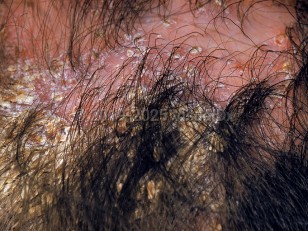Favus - Hair and Scalp
Alerts and Notices
Important News & Links
Synopsis

Favus (tinea favosa), a Latin word meaning honeycomb, is a severe form of tinea capitis caused most often by Trichophyton schoenleinii. Occasionally, Trichophyton violaceum or Microsporum species may cause a similar condition.
While favus used to occur worldwide, vast improvements in socioeconomic conditions have limited it to areas where the population suffers from poor hygiene and malnutrition. Currently, favus is mostly seen in Africa, some parts of Asia and the Middle East, and some parts of Eastern Europe; it is rarely encountered in the United States or Western Europe. Typically, scalp favus is acquired during childhood through close contact with other affected individuals. Combs and hairbrushes remain an important source of infection.
Scalp favus presents first as erythematous papules surrounding intact hair follicles. The papules become more inflamed and eventually develop characteristic thick, yellow-brown crusts composed of hyphae and keratin debris, resembling a honeycomb. T schoenleinii is an endothrix (residing within the hair shaft), and it destroys the hair shaft, eventuating in hair loss. Left untreated, concave, cup-shaped debris (termed scutula) steadily engulf ever more hair, leading to a progressive scarring alopecia.
While favus used to occur worldwide, vast improvements in socioeconomic conditions have limited it to areas where the population suffers from poor hygiene and malnutrition. Currently, favus is mostly seen in Africa, some parts of Asia and the Middle East, and some parts of Eastern Europe; it is rarely encountered in the United States or Western Europe. Typically, scalp favus is acquired during childhood through close contact with other affected individuals. Combs and hairbrushes remain an important source of infection.
Scalp favus presents first as erythematous papules surrounding intact hair follicles. The papules become more inflamed and eventually develop characteristic thick, yellow-brown crusts composed of hyphae and keratin debris, resembling a honeycomb. T schoenleinii is an endothrix (residing within the hair shaft), and it destroys the hair shaft, eventuating in hair loss. Left untreated, concave, cup-shaped debris (termed scutula) steadily engulf ever more hair, leading to a progressive scarring alopecia.
Codes
ICD10CM:
B35.9 – Dermatophytosis, unspecified
SNOMEDCT:
85375000 – Tinea favosa
B35.9 – Dermatophytosis, unspecified
SNOMEDCT:
85375000 – Tinea favosa
Look For
Subscription Required
Diagnostic Pearls
Subscription Required
Differential Diagnosis & Pitfalls

To perform a comparison, select diagnoses from the classic differential
Subscription Required
Best Tests
Subscription Required
Management Pearls
Subscription Required
Therapy
Subscription Required
References
Subscription Required
Last Reviewed:08/15/2019
Last Updated:09/08/2019
Last Updated:09/08/2019
Favus - Hair and Scalp

